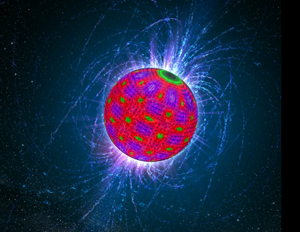The seismic vibrations of the stars can reveal valuable information about their age, size and internal dynamics. The Kepler telescope from NASA, dedicated specifically to search for extrasolar planets, is only entered as 100,000.
In English we call them "starquake, earthquakes star (or perhaps it would be more correct to call them" stellemoti?). Are vibrations that shake the surface of the star, whose analysis you can discover a lot about the star itself: how many years and than he still has, its structure, as it is, forming storms and starspots. Just as earthquakes on Earth, as it is revealing the internal structure of our planet, so the way in which the stars of their range is a spy hidden features.
This concept, which in itself does not have anything particularly original, now has the chance to be put to work on a large scale by NASA's Kepler mission. The program Kepler Asteroseismic Investigation aims to monitor the vibration surface of thousands of stars to find out more about them.
Although its primary mission remains to hunt down the extrasolar planets similar to Earth, the technical capabilities of the space telescope allow to obtain, as they say, two birds with one stone. In fact, the mechanism by which Kepler identifies exoplanets is the same that can detect the stellar vibrations. Thanks all'avanzatissima technology captures the subtle variations in brightness of a star when a planet (a microbe to the comparison) in front of the orbit. Even the seismic oscillations affecting the area of the disk, resulting in considerable changes in the brightness of the star. So Kepler has been collecting secret information about 100,000 stars.
The seismic waves in the stars are the result of turbulent convection inside. When the waves hit the surface, it begins to vibrate like a bell. Since the speed of wave propagation depends on its internal structure, that's what scientists can deduce there is still hydrogen in the star (it is the fuel for thermonuclear fusion reactions), estimating how long it shines and how long it will go ahead before disappearing. A celestial dating useful to refine models of stellar evolution. And most of all to get to know the galactic neighbors.
Anche le stelle tremano
Le vibrazioni sismiche delle stelle possono rivelare preziose informazioni sulla loro età, dimensione e dinamica interna. Il telescopio Kepler della NASA, dedicato specificatamente alla ricerca di pianeti extrasolari, sta schedando così 100.000 soli.In inglese li chiamano “starquake”, terremoti stellari (o forse sarebbe più corretto chiamarli “stellemoti”?). Sono vibrazioni che scuotono la superficie delle stelle, dalla cui analisi è possibile scoprire molto sulla stella stessa: quanti anni ha e quanti gliene restano, com’è fatta la sua struttura, dove si formano le tempeste e le macchie stellari. Proprio come i terremoti sulla Terra rivelano com’è fatta la struttura interna del nostro pianeta, così il modo in cui le stelle oscillano è una spia delle loro caratteristiche nascoste.
Questo concetto, che in sé non ha nulla di particolarmente originale, ora ha la possibilità di essere messo all’opera su grande scala grazie alla missione Kepler della NASA. Il programma Kepler Asteroseismic Investigation mira a monitorare le vibrazioni superficiali di migliaia di stelle per scoprire di più sul loro conto.
Sebbene la sua principale missione resti dare la caccia ai pianeti extrasolari simili alla Terra, le capacità tecniche del telescopio spaziale permettono di ottenere, come si suol dire, due piccioni con una fava. Infatti il meccanismo con cui Kepler individua esopianeti è lo stesso che permette di rilevare le vibrazioni stellari. Grazie all’avanzatissima tecnologia, riesce a cogliere le impercettibili variazioni di luminosità di una stella quando un pianeta (un microbo al confronto) gli orbita davanti. Anche le oscillazioni sismiche alterano l’area del disco, producendo sensibili cambiamenti nella luminosità della stella. Così Kepler sta collezionando informazioni segrete su 100.000 stelle.
Le onde sismiche nelle stelle sono il risultato di turbolenti moti convettivi all’interno. Quando le onde colpiscono la superficie, questa si mette a vibrare come una campana. Poiché la velocità di propagazione delle onde dipende dalla sua struttura interna, ecco che gli scienziati riescono a dedurre quanto idrogeno c’è ancora nella stella (è il combustibile delle reazioni di fusione termonucleare), stimando da quanto tempo brilla e quanto tempo potrà andare avanti, prima di spegnersi. Una datazione celeste utile per raffinare i modelli di evoluzione stellare. E soprattutto per conoscere da vicino le vicine galattiche.


This post is in fact a fastidious one it helps new
RispondiEliminaweb viewers, who are wishing in favor of blogging.
My page - selection process